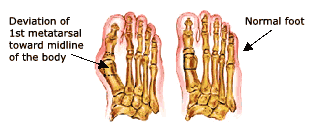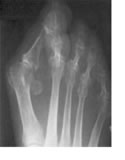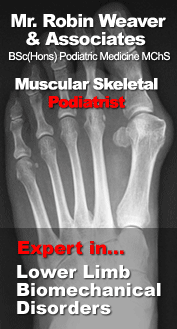 Bunions
Bunions
What are bunions?

'Bunions' or hallux valgus is
a condition that affects the bones and joints associated with
the big toe. It is one of the most common deformities of
the forefoot. The condition usually develops slowly and results
from the gradual dislocation of the joint, normally because
of instability during gait (the way in which an individual
walks).
There is a gradual displacement of the first metatarsal
bone toward the mid-line of the body, and a simultaneous
displacement of the big toe away from the mid-line toward the smaller
toes. This causes a prominence of bone on the inside (medial)
margin of the forefoot; this is termed a bunion.
As the deformity progresses, the big toe will shift toward
the outside of the foot. In severe cases, the big toe will
actually overlap or underlap the second toe. Due to shoe
irritation the bones within the big toe joint may actually
become thicker and a protective fluid filled sack called
a bursa, may form.
Bunions are often hereditary in nature, but are also
associated with diseases such as rheumatoid arthritis. The
incidence of bunions is much higher in women than men. This
was thought to be caused purely by shoe fashion; however over
recent decades genetic factors and certain other predisposing
abnormalities of foot function have been implicated in bunion
development.
The role of genetics in bunion development has been emphasised
by studies that show that the rates of bunions within cultures
that do not wear shoes are the same as cultures that wear
shoes. However wearing narrow toed and high heeled shoes can
greatly accelerate the formation of a bunion.
Orthotics
are medical devices that are worn inside the shoes and are prescribed
by a Podiatrist after a careful assessment. Orthotics can slow or halt the progression of bunions
by addressing the instability which causes the deformity, often providing complete symptomatic relief. However orthotics
cannot reduce the pre-existing bony deformity.
When a bunion becomes problematic (through either making shoe
fitting difficult, or increased pain) surgery may be performed to correct the
deformity. Following bunion surgery, foot orthotics should
be worn to prevent the faulty foot mechanics that caused the
bunion; otherwise bunion recurrence is likely.
Symptoms
- Redness, swelling, or pain along the inside margin of
the foot just behind the big toe
- Moderate to severe discomfort at the site of the bunion when wearing
shoes, particularly if tight fitting.
- A painful callus may develop over the bunion.
- There may be a painful corn on the adjacent sides of
the first and second toes.
- There may be irritation caused by overlapping of the first
and second toes.
- There may be stiffness and discomfort in the joint
between the big toe and the first metatarsal.
- There may be a fluid-filled cyst or bursa between the
skin and the "bunion bone".
- Skin over the bunion may break down, causing an ulceration
which can become infected.
Causes
- Abnormality in foot function, particularly a pronated
foot. This is probably the most important and common causative
factor.
- Family history of bunions.
- Narrow-toed dress shoes and high heels may contribute
to the formation of a bunion.
- Rheumatoid and Psoriatic arthritis.
- Genetic and neuromuscular disease (eg. Down's, Ehler-Danlos
and Marfan's syndromes) resulting in muscle imbalance.
- Limb length inequality can cause a bunion on the longer
limb.
- Generalized laxity of the ligaments.
- Trauma to or surgery on the soft tissue structures around
the great toe (first metatarsal-phalangeal) joint.
What You Can Do
- Apply a commercial bunion pad around the bony prominence,
use only non-medicated pads.
- Wear shoes with a wide and deep toe box. You should be
able to "dimple" the leather over your bunion.
- Avoid all high heeled shoes.
- If your bunion becomes painful, red and swollen, try elevating
your foot and applying ice for about 20 minuets every hour.
- If symptoms persist, consult a Podiatrist.
- Use a prefabricated pronation control orthotic such as the Orthosport Activ-8 ™ orthotic, a perfect choice for moderate over pronators.
What the Podiatrist May Do
- Prescribe functional orthotics to correct faulty foot
function, and help prevent worsening of the deformity.
- Apply special pads and dressings to protect the bunion
from shoe pressure.
- Inject steroid and local anaesthetic around the bunion
to reduce inflammation. This is especially useful if there
is an associated bursitis ( a fluid-filled cyst or sack
between the skin and the "bunion bone").
- Apply various splints or digital orthotics to reposition
the great toe joint.
- Recommend commercially available or custom-made shoes.
- Recommend bunion surgery to correct the deformity.
Other Causes Of Pain At The Big Toe Joint
- Arthritis in the first metatarsal-phalangeal joint
- Injury to the soft tissue structures around the first
metatarsal-phalangeal joint.
- Fracture of the great toe or first metatarsal.
- Tight shoes may cause pain in an otherwise normal joint.
- Sesamoiditis-an inflammation of one or both small
bones which rest in tendons under the first metatarsal-phalangeal
joint.
X-rays of bunions
 This
x-ray illustrates a severe bunion deformity. This
x-ray illustrates a severe bunion deformity.
- The first metatarsal has deviated towards the mid-line
of the body, resulting in a prominence of the first metatarsal
head on the inside border of the foot. This is what is known
as a bunion.
- There is a marked deviation of the big toe toward the
lesser toes. The big toe is now resting under the second
toe.
- There is bone formation along the inside border of the
first metatarsal head. This is a protective bursa, formed
as the result of repeated shoe pressure.
- The bones resting between the first and second metatarsals
are called sesamoid bones. They normally rest in small tendons
beneath the first metatarsal head. As the bones displace
with the formation of a bunion, these come to lie in the
interspace.
- The second toe has contracted termed a 'hammer
toe'.
|

